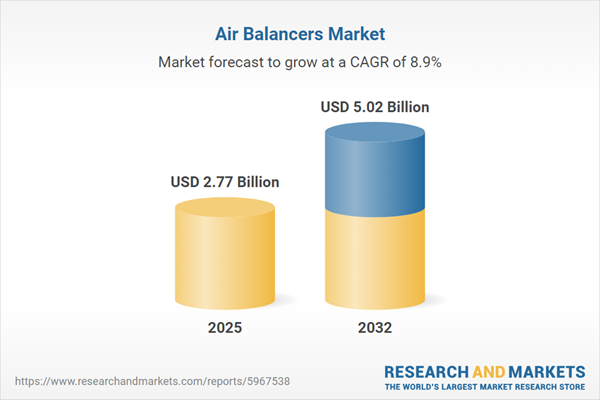Speak directly to the analyst to clarify any post sales queries you may have.
The air balancers market is undergoing significant transformation as industrial leaders pursue solutions that enhance process efficiency, safety, and workforce adaptability. These systems have become foundational in aligning operational goals with modern technological advancements and changing business models.
Market Snapshot: Air Balancers Market Size and Growth Overview
The global air balancers market is projected to grow from USD 2.54 billion in 2024 to USD 2.77 billion in 2025, reaching an estimated value of USD 5.02 billion by 2032. This steady growth is underpinned by ongoing advancements in industrial automation, evolving workplace safety policies, and continuous emphasis on process optimization across manufacturing environments. Manufacturers are actively integrating air balancers into increasingly complex production networks, supporting broader modernization goals and improving operational responsiveness in multiple sectors.
Scope & Segmentation: Air Balancers Market Analysis
- Type: Electric air balancers are designed for precise movement management in high-performance operations. Mechanical variants feature robust construction and reduced maintenance, fitting continuous manufacturing needs. Pneumatic options facilitate rapid throughput and enhance operator safety, particularly where flexibility and accident prevention are top priorities.
- Application: Use of air balancers is critical for safe, ergonomic material handling and streamlining tasks prone to repetition. Their deployment is substantial in packaging, assembly, welding, and other industries seeking smooth collaboration between human and automated processes.
- Industry: Air balancers serve a broad spectrum of sectors, including aerospace, commercial and passenger vehicles, food and beverage, and process industries where precision, dependability, and productivity improvements are vital for competitiveness.
- Distribution Channel: Companies acquire air balancers via direct procurement, aftermarket partners, OEM agreements, and specialized distributors, ensuring tailored integration and continued service support.
- Geographic Coverage: The Americas display extensive adoption, supported by lasting investments across Europe, the Middle East, and Africa. Asia-Pacific’s accelerated implementation is driven by rapid industrial growth in China, India, Japan, and South Korea and an intensified focus on modernization and flexibility.
- Key Companies Profiled: Key market players such as Ingersoll-Rand, Atlas Copco AB, SMC Corporation, Festo AG, Parker-Hannifin Corporation, IMI plc, DEMMELER GmbH, AirBalancer Systems, Stephen H. Olive Company, and Pilot Air Systems shape competitive dynamics through product innovation, strategic launches, and partnerships focused on user requirements.
Key Takeaways: Strategic Insights for Senior Executives
- IoT-enabled air balancer solutions are increasing visibility and control, supporting predictive maintenance while reinforcing workplace safety through real-time operational data.
- Procurement efforts are shifting towards air balancers with reduced noise and emissions, advancing sustainability and compliance with modern ergonomic standards and local regulations.
- Swift adoption in the Asia-Pacific region is prompting organizations to reconfigure their supply networks, fostering improved supply chain resilience and enhanced alignment among suppliers.
- Leaders are adopting decentralized production models, increasing agility to address evolving market and logistical challenges without sacrificing operational consistency.
- Comprehensive service agreements that include proactive support and maintenance are essential in sustaining high system availability and maximizing asset longevity across industrial sites.
Tariff Impact and Shifting Competitive Dynamics
Recent tariff adjustments in the U.S. on mechanical and pneumatic components are compelling manufacturers to prioritize domestic sourcing and diversify their supply base. This shift encourages closer relationships with local distributors and renewed collaboration with OEMs, shaping product innovation and supporting supply chain flexibility as well as the rapid introduction of new air balancer solutions.
Methodology & Data Sources
This study is based on direct interviews with procurement professionals, technical advisors, and integration specialists. Findings are validated by experienced industry stakeholders and supported with analysis from technical documentation, regulatory literature, patent data, and company announcements to ensure reliability and current relevance.
Why This Report Matters
- Gives senior leadership actionable insights to align air balancer strategies with operational objectives and changing compliance requirements.
- Supports robust risk management, procurement planning, and strategies aimed at enhancing employee safety and operational continuity throughout manufacturing and logistics operations.
- Enables organizations to refine distribution systems, improve material handling processes, and realize measurable gains in productivity and workplace safety.
Conclusion
Integrating air balancers into industrial operations offers sustained improvements in efficiency, safety, and regulatory compliance. These systems support organizations in navigating shifting industry landscapes and pursuing scalable growth over time.
Additional Product Information:
- Purchase of this report includes 1 year online access with quarterly updates.
- This report can be updated on request. Please contact our Customer Experience team using the Ask a Question widget on our website.
Table of Contents
3. Executive Summary
4. Market Overview
7. Cumulative Impact of Artificial Intelligence 2025
Companies Mentioned
The companies profiled in this Air Balancers market report include:- Ingersoll-Rand, Inc.
- Atlas Copco AB
- SMC Corporation
- Festo AG
- Parker-Hannifin Corporation
- IMI plc
- DEMMELER GmbH
- AirBalancer Systems, Inc.
- Stephen H. Olive Company
- Pilot Air Systems, Inc.
Table Information
| Report Attribute | Details |
|---|---|
| No. of Pages | 185 |
| Published | October 2025 |
| Forecast Period | 2025 - 2032 |
| Estimated Market Value ( USD | $ 2.77 Billion |
| Forecasted Market Value ( USD | $ 5.02 Billion |
| Compound Annual Growth Rate | 8.8% |
| Regions Covered | Global |
| No. of Companies Mentioned | 11 |









